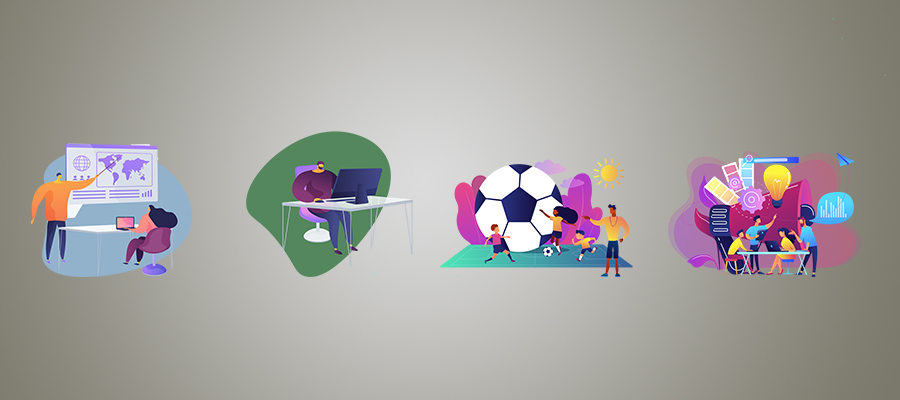We all might have our theories about learning and our preferences for one way of learning over another. Harvard professor Richard Elmore puts forward this conception in four main modes of learning organized around two axes: individual or collective centred and hierarchical or free. This theoretical framework, which he has been presenting for several years in the MOOC Leaders of Learning, aims to help individuals and organizations to identify in which quadrant they are situated and towards which conception they wish to evolve. Let’s take a closer look at what it consists of.
The 4 modes

Hierarchical individual
Learning in this quadrant focuses on individual achievement and performance. Corresponding to “traditional” teaching, it is here that the teacher transmits knowledge to the learner within a competitive system where the parameters of success are clearly defined, and the learner’s progress is evaluated. The structure of knowledge acquisition is chronological: starting with basic notions, one progresses towards more advanced notions and the level of complexity increases with the age group. Each learner is responsible for his or her own performance.
Hierarchical collective
Learning in this quadrant is equivalent in some ways to “individual hierarchical” learning, but is focused on group activity. The competitive spirit of the individual model, however, gives way here to group and self-help, with social-cognitive development as the main learning objective. The learning acquisition structure is chronological. The parameters of success are clearly defined, and the learner’s progress is evaluated.
Distributed individual
In this quadrant, it is the learner who undertakes a learning process on his or her own, chooses his or her objects of study, determines his or her sources and means, and sets his or her goals. All the choices here are therefore personal to the individual, who is considered to be a learner “by nature” – his or her initiative being based at least on his or her personal learning skills. In general, no teacher is involved in this individual approach, which is also well served by the tools of the digital world – the Internet and Web 2.0 in particular – and online training.
Distributed collective
In this quadrant, learning relies on self-organized networks of individuals who share common interests. It underlies the idea that everyone is capable of learning outside of hierarchical frameworks. Alternatively, members of these networks acquire and transmit information according to their respective levels of knowledge and expertise. Common priorities, respect and cooperation among members of the community are key to the success of this mode of learning.
What you need to know
- Most of us have experienced all four modes of learning in our lives. Our ability or preference for one of them may depend on our personal disposition, the accessibility or organization of these modes of learning, or the type of learning involved – e.g., assimilating a mathematical formula is not the same as learning to be a good player in a team sport.
- While we might tend to favour one of these four conceptions of learning, this does not mean that we could not prefer another after exploring it further or at least moving closer to the boundaries of another quadrant.
- Ideally, we should be exposed to a mix of the four modes of learning in order to be more versatile as a learner and to be able to choose, depending on the circumstances, the one that suits us best. In the same vein, in order to improve his or her learning abilities, it is in every learner’s interest to develop autonomy and metacognitive skills (see Metacognition 101 and Develop Your Metacognitive Skills).
- Online training is one of the best ways to not only optimize individual learning but also to take advantage of social learning networks. It also makes possible the integration of a form of hierarchical authority, as is the case for training provided by educational institutions that leads to certification.
- Among the factors that are reshaping learning, the digital world is inescapable. In short: it provides access to an unlimited amount of content (knowledge); it fosters networking and knowledge sharing among groups of people with common interests; and it helps us connect with people who can help us along the way, whether it be for their expertise in pedagogy or in the field we are interested in. As learning becomes accessible anytime, anywhere, and outside formal organizations designed for this purpose, it tends to move from the hierarchical to the distributed axis and from the individual to the collective axis.
Related articles :
- Metacognition 101
- Develop Your Metacognitive Skills
- Self-training 101
- Self-Training: The Evolution of a Fundamental Concept
- 6 Conceptions of Learning… Which One Is Yours?
- 7 thoughts on informal learning
- Informal Learning 101
- Finding Your Spot in the Learning Zone
- Online learning: 6 types of interactions at play
Author:
Catherine Meilleur
Creative Content Writer @KnowledgeOne. Questioner of questions. Hyperflexible stubborn. Contemplative yogi.
Catherine Meilleur has over 15 years of experience in research and writing. Having worked as a journalist and educational designer, she is interested in everything related to learning: from educational psychology to neuroscience, and the latest innovations that can serve learners, such as virtual and augmented reality. She is also passionate about issues related to the future of education at a time when a real revolution is taking place, propelled by digital technology and artificial intelligence.







Leave A Comment